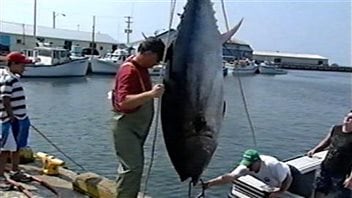The 19th meeting of International Commission for the Conservation of Atlantic Tunas (ICCAT) concluded this week in Genoa, Italy with decision to raise quotas on bluefin tuna.
Among conservationists there is great surprise and shock at the decision. The government said in a press release that the request for an increase was based on scientific advice and that the “Western Atlantic Bluefin tuna 2014 stock status update indicates the stock has grown substantially in recent years and could support such an increase.”
The committee approved the increase in spite of it’s own report saying there were significant lapses in data about the health of the stocks, their migrations and reporting, concluding, “conclusions of this assessment do not capture the full degree of uncertainty in the assessments and projections.” In fact the report indicated lapses in data in all species under its jurisdiction.

The total allowable catch (TAC) for western Atlantic tuna was increased from 1,750 tonnes to 2,000 tonnes. Canadian officials advocated the increase saying evidence showed tuna stocks were increasing. Canada’s TAC for 2015-2016 will be 452.5 tonnes annually, a 15% increase over this year, with the possibility of up to an additional 108,9 tonnes transferred from Mexico’s quota if available.
Katie Shleit of the Ecology Action Centre says the increase will hamper recovery efforts for the species. Rachel Hopkins of the Pew Charitable Trusts, an independent research group, also questions the quota increase. She argues that the stock remains depleted compared to 1970s levels, adding that U.S. fishermen haven’t been able to catch their full quota since 2003.
While fishermen in the Gulf of St Lawrence report seeing increased numbers of Bluefin, Shleit and Hopkins argue that could simply mena the fish have shifted north, and do not necessarily represent an increase in numbers.
In a report in 2011, the Committee on the Status of Endangered Wildlife in Canada (COSEWIC) wrote, “This iconic fish has been heavily exploited for over 40 years and the current abundance of spawning individuals is the lowest observed. Fishing is the main threat to the viability of the species and despite management efforts for the past 30 years to rebuild the population, there is little sign of population increase. The abundance of spawning fish has declined by 69% over the past 2.7 generations. While the cause of the decline, overfishing, is understood, it has not ceased and it is not clearly reversible. The spawning segment of the species was exposed to the Deepwater Horizon oil spill in a portion of its spawning area in the Gulf of Mexico. While the effects of the spill on the species are currently unknown, it may represent an additional threat.”
It had recommended that the species be listed as endangered under the Species at Risk Act, but that recommendation was not acted upon.







For reasons beyond our control, and for an undetermined period of time, our comment section is now closed. However, our social networks remain open to your contributions.